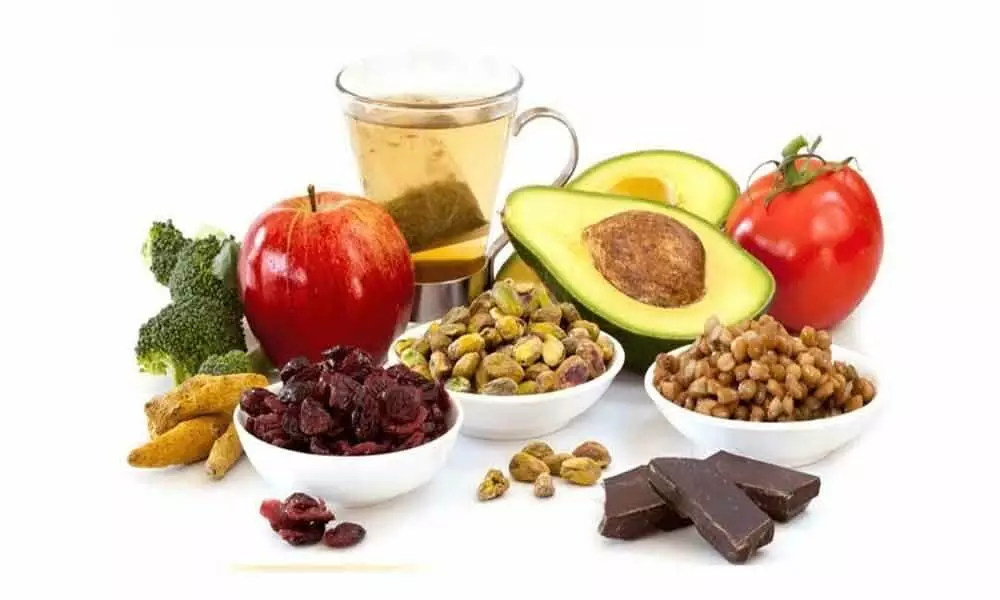Dietary flavonoids: A boon from the nature!
Daily intake of 100mg of flavonoids may reduce the risk of developing morbidity and mortality due to coronary heart diseases (CHD) by approximately 10%: Study
image for illustrative purpose

Flavonoids are polyphenolic compounds that occur ubiquitously in foods of plant origin. These have beneficial effects because of their antioxidant properties. Major classes of flavonoids include flavanols, flavones, flavanols, flavanones, isoflavanones and anthocyanidines.
Best sources of dietary flavonoids are berries, red cabbage (anthocyanidines), onions, kale, parsley, tea, red wine, dark chocolate. Recent scientific studies revealed that flavanoids are also found in bananas, can reduce the risk of heart diseases. Flavanol glycocides might contribute to the antioxidant defences of blood. Free flavanoids without a sugar molecule, the so-called aglycones, were thought to be able to pass through the gut wall. Hydrolysis only occurs in the colon by microorganisms which at the same time degrade flavanoids.
Flavanoids are now considered as an indispensable component in a variety of medicinal pharmaceutical, neutraceutical and cosmetic preparations. Moreover, these play a significant role in preventing cardiovascular diseases (CVDs) which could be mainly due to their antioxidant, antiatherogenic and anti thrombotic effects.
One study suggests that daily intake of 100mg of these through the diet may reduce the risk of developing morbidity and mortality due to coronary heart diseases (CHD) by approximately 10 per cent.
Dietary flavonoids as antioxidants
Flavonoids are involved in protection against harsh environmental conditions, UV radiation and microorganism attacks in plants. Because of their potent antioxidant activity against oxidative stress the interest in flavonoids has recently increased. In-vitro and In-vivo studies have demonstrated that they have anti-carcinogenic properties against different types of cancers. These secondary metabolites are synthesized mainly by plants. To date, more than 6000 different flavonoids have been identified and they are distributed in a wide range of plants.
The general structure of flavonoids is composed of a 15-carbon skeleton containing 2 benzene rings connected by a 3 carbon linking chain. Therefore, they are depicted as C6C3C6 compounds. Flavonoids are widely spread in different foods and beverages such as wine and tea but the sources with the highest levels are fruits and vegetables. Among fruits, highest levels of flavonoids are found in berries such as black elderberry and black choke berry. In the drupes group, some fruits such as plum and sweet cherry have higher levels of flavonoids than the rest of the group. In the pomes group, apple has the level of 56.35 mg.
Furthermore, tropical fruits have a very low flavonoid content. Depending on the type of fruit, the main flavonoid subclass groups vary. Anthocyanines predominate in berries, flavonoids predominate in pomes, tropical fruits and drupes except in sweet cherry. Regarding veggies, the foods with the highest levels of flavonoids are broad beans pod, black olive, red onion, spinach, shallots. Except for broad bean pod, the predominate flavonoid subclass in vegetables is flavonols.
Regarding seeds, although common bean has high levels of flavonoids, the foods with highest levels are those derived from soy and soy products. They have been suggested to play a key role in the prevention of different diseases.
Regarding cereals, some such as barley, buckwheat and common wheat contain average levels of flavonoids. However, it is important to note that the highest levels are found in wholegrains and levels are greatly reduced when grains are heat-treated or refined.
Regarding oils, the data collected from the phenol explorer database refer only to oils made from olives.
For beverages, a distinction can be made between non-alcoholic and alcoholic drinks. The non-alcoholic drinks with the highest levels of flavonoids are tea infusions particularly black and green tea and these are mainly flavonols. The second-most flavonoid rich beverages are fruit juices notably pure apple juice, pure orange juice, pure grape juice and pure lemon juice. The main flavonoids in citrus juices and grapefruit are flavanones. However, the main flavonoids in pome juices are flavonols.
Regarding alcoholic beverages, the red wine contains the highest level of flavonoids. Therefore, a diet rich in fruits, vegetables, seeds and cereals will provide a large amount of flavonoids. However it is important to know that there are some foods which contain high quantities of flavonoids including berries, black olives, spinach, onions, soy products, cocoa, whole green cereals, tea infusions and red wine.
(The author is School Assistant (Bio-Sciences), ZPHS, Mulapadu, Ibrahimpatnam Mandal, Krishna District, Andhra Pradesh)

